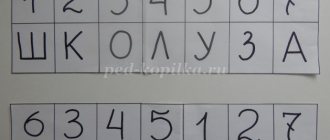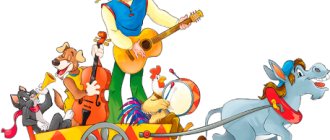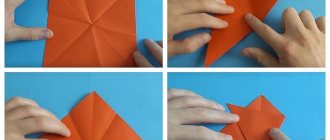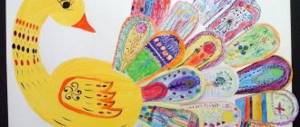Extracurricular event “Magic Chest”
Topic: “Magic Chest” Objectives: 1. consolidate knowledge about natural phenomena in the autumn period, about cultivated plants and their centers of origin, about the diversity of flora and fauna; 2. develop interest in the creative search for original solutions, quick thinking, quick wit; 3. learn to apply your strengths and knowledge in practice; 4. cultivate a sense of friendship and cohesion in children, cultivate a caring attitude towards nature. Equipment: a 2 by 2 meter field, drawings of “rowan” and “maple” signs, dummies of vegetables, a “black box”, paper, pencils, blindfolds, 2 balls, 2 postcards, costumes for “babies”. Preparing for the game. 1. Draw a field with a format of 2 by 2 meters. The cells of the playing field are numbered and filled with the names of nine competitions. The number “9” serves as a symbol of the game. 1 Black Box 2 Through the Mouth of a Baby 3 Erudite 4 Relay Race 5 Changelings 6 Mosaic 7 Autographs 8 Who's Faster? 9 Blitz tournament 2. 2 teams of 9 people are formed. Creative presentations of teams (“business cards”) are prepared. 3. The composition of the jury is determined. Conditions of the game. 1. The team that wins the competition places its sign on the playing field (one team has “rowan” signs, the other “maples”). 2. The losing team in the competition has the right to choose a new square on the playing field, thereby determining the game in the next competition. 3. The winner of the game is the team that manages to line up three of its signs in one row (horizontally, vertically, diagonally) during the game. This is the main essence of the game. If the teams fail to line up three of their signs in a row during the game, then in this case all 9 competitions are played, all the cells of the playing field “rowanberry” and “maple” are filled, and the team with the most signs on the playing field wins. Progress of the game. 1. Announcement of the theme and goals of the game. 2. The team sign is determined by lot. Some participants in the game become “rowan trees”, others “maples”. The presenter gives the teams insignia. 3. The jury members are introduced. Each person is given two plaques: on one there is a sign of “rowanberry”, on the other there is a sign of “maples”. These are competitive assessments. 4. Familiarity with the rules of the game. 5. The right to choose a square on the playing field is played out, the teams show their creative performance. The jury evaluates the performance. The team that has collected the most characters selects a cell on the playing field for the first competition task. 6. After each competition there are small breaks: concert numbers, performances by jury members, games with the audience. 7. At the end of the game, the results are summed up, the winning team is determined, and awards are presented. Competitions: 1. “Black box”. To the music, a black box is brought out, containing 2 packages with something (one for one team, the other for the second team). You have to guess what's in the box. Conditions of the competition: in turn, each team member asks the presenter only one question, which can be answered with “yes” or “no”. After asking nine questions, the team, after consulting for 1 minute, names what they think is in this box. (For example: is it edible?, does it grow in the garden? and so on). The box contains dummies of some vegetable or fruit. 2. “Through the mouth of a baby.” “Kids” come to visit with tasks for the players. Each team has two tasks. The sooner the team guesses what the “kid” wants to say, the more points they will earn and cover this playing field with their sign. If the teams still haven’t guessed it, the spectators come into the game and help the team they are rooting for. 1) 1. It is flammable and burns quickly. 2. This is what makes the air cleaner. 3. It is very prickly and at the same time fluffy. 4. This is the same color in winter and summer. 5. This is something that no New Year’s holiday can do without. (Christmas tree) 2) 1. This is something that almost no dish can do without. 2. It contains a lot of vitamins, especially a lot of vitamin C and E. 3. My mother gives me this when I have the flu, but I can’t stand it. 4. They sometimes say about him: “angry as a dog.” 5. When they undress him, tears are shed. (bow) 3) 1. It was invented by the Chinese. 2. It produces a lot of garbage. 3. It burns easily. 4. It is obtained from wood. 5. People usually draw or write on it. (paper) 4) 1. It is made from sand. 2. Most often it is transparent. 3. When it falls it breaks. 4. If you heat it up, it becomes sticky like dough. 5. If abandoned in the forest, it can become a source of fire. (glass) 3. “Erudite.” Teams are offered a series of questions to which they give answers without discussion; if there is no answer, they say the word “next”. Within 1 minute you must answer more questions correctly. Questions for the Ryabinka team. 1. Is a ruminant a “ship of the desert”? (camel) 2. A device for determining the sides of the horizon? (compass) 3. Little rabbits born in the fall? (deciduous) 4. The largest animal on land? (elephant) 5. The largest animal in the ocean? (whale) 6. Desert plant with fleshy stem, thorny leaves? (aloe, cactus) 7. What is the main food for deer in the tundra in winter? (moss moss lichen) 8. What is worse for birds in winter, cold or hunger? (hunger) 9. Migratory animals? (bats) 10. Like pines, like fir trees, but in winter without needles? (larch) 11. Which month has 28 days? (in any) 12. Where do hedgehogs, badgers, and bears disappear for the winter? (go to bed) 13. What vegetable plant did the French queen decorate herself with? (potato flowers) 14. Does a bear go to the den skinny or fat? (bold) 15. One of the largest leaf buds? (head of cabbage) Questions for the Kleny team. 1. Who travels through the air on a string? (spider) 2. Who does the cat catch? (mice) 3. What comes after autumn? (winter) 4. Which flower starts spring? (snowdrop) 5. “Flower of the sun”? (sunflower) 6. Does it grow in the ground, but the scythe is outside? (carrot) 7. What does the first half of an apple look like? (for the second half of the apple) 8. A medicinal plant growing near the roads? (plantain) 9. Which animal has bags instead of cheeks? (hamster, chipmunk) 10. The smallest bird in the world? (hummingbird) 11. What peas in some countries replaced money in ancient times? (black peppercorns) 12. The largest flower in the world? (Rafflesia: weight up to 7 kg, diameter up to 1 meter) 13. A plant whose fruits contain a large amount of vitamin C? (lemon) 14. Which bird is named after the dance? (tap dance) 15. This plant is called the “breadwinner of the East.” What kind of plant is this? (fig) 4. “Relay Race” - cheerful artists. “Artists” - players are given a topic: to draw an autumn sketch. At the leader’s command, the players run up to the easel, put on a blindfold, take a pencil and begin to draw. Then, on command, they take off the bandage and run to their team, the bandage is passed to the next player. This player puts on a headband and continues the interrupted pattern. The team that draws without any major mistakes wins. 5. “Shifters.” To match the names of non-existent plants that are directly opposite in meaning, you need to match the names of well-known plants. (For example: Tanya's eyes - Pansies) If the team finds it difficult to answer, the audience comes into play. 1. Father - and - stepfather (mother - and - stepmother) 2. Sugar (oxalis) 3. Contemporary (colchicum) 4. Healthy head (hemlock) 5. Hare's bast (wolf's bast) 6. Animal lover (St. John's wort) 7. Vasily - yes - Olga (Ivan - yes - Marya) 8. Marya - coffee (Ivan - tea) 9. Fly agaric (fly agaric) 10. Forget-me-not (forget-me-not) 11. Late flower (primrose) 12. Podushnik (plantain) 13. Gardener (motherwort) 14. Varenka (russula) 15. Wolf's eye (crow's eye) 16. Insomnia grass (sleep grass) 6. “Mosaic”. The children of both teams are given rectangles with the same tasks. The mosaic pieces are mixed up in them. Players need to put them in such an order that they get a whole phrase. Whose team completes the puzzle and reads the phrase faster will be the winner. One minute is given to complete the task. (In the letter, Autumn congratulates the guys on the onset of the holidays.) 7. “Autographs.” One player from each team is a boy. They are given the task of collecting as many autographs as possible from the girls in the audience. You have 1 minute to complete the task. Whoever gets the most autographs wins. 8. “Who is faster?” Hold the ball with your chin and pass it without using your hands to another participant. The ball should not fall. Whose team completes the task faster wins. The task is performed to music. 9. “Blitz tournament.” Teams are asked three questions, each given 30 seconds to discuss. Questions for the Ryabinka team. 1. What was called the second “bread” in Rus' in the old days? or more precisely: what vegetable? (turnip) 2. The ancient inhabitants of America deified this plant and depicted the god of rain with its shoot. What kind of plant is this? (This is corn - the oldest cereal of the American continent, the remains of cobs found in caves in Mexico are 3000-5000 years old) 3. Which flower means “star” and symbolizes joy? (aster) Questions for the Kleny team. 1. What vegetable did the ancient Romans call “head”? (cabbage, comes from the ancient Roman word “kaput”, which means head) 2. Why is hyacinth called the “flower of rains”? (The flower’s homeland is Asia Minor, and the name translated from Greek means “flower of rains,” since the flowering period of the plant coincides with the onset of the warm spring rainy season in its homeland) 3. In Ancient Egypt, this vegetable was used to feed slaves during the construction of the pyramids so that they did not get sick, since this plant contains a large amount of phytoncides, it is a brother of onions. (garlic). Playing with the audience If the name of a plant that grows in Russia is called, then the children clap, if not, they stomp: beets, carrots, sea buckthorn, birch, cactus, garlic, cabbage, mimosa, spruce, cucumber, lemon, orange, cocoa, wheat, pine, tangerine, cotton, aspen, banana. Coffee, rowan, banyan, tobacco, sequoia, burdock, tea, baobab, Winnie the Pooh
Musical and literary evening “Magic Chest”
The background of a children's song sounds
Ved. 1
GOOD AFTERNOON, DEAR VIEWERS! CHILDREN AND PARENTS! HERE IS A MAGICAL CHEST WITH A LOCK ON THE DOOR.
IN IT LIVE THE SOLUTIONS TO ALL MY RIDDLES WHO WILL GUESS THAT LOCK AND OPEN THE Riddle
CHOOSE ALL RIDDLES ACCORDING TO THE KEY.
(Representatives from teams (3) choose keys)
PUZZLES
1. You take it in your hands, you will stretch it, then you will squeeze it! Voiced, elegant, Russian, two-row. She'll play, just touch her. What's her name? (Harmonic)
2. Wooden girlfriends Dance on the top of his head, Beat him, and he thunders - Orders everyone to keep pace. (Drum)
3. I stand on three legs, My feet are in black boots. White teeth, pedal. What's my name? (Piano)
4. I wish the evening would quickly approach, And the long-awaited hour would come, So that I could go to a fairy-tale ball in a gilded carriage! No one in the palace will know where I come from or what my name is, But as soon as midnight comes, I will return to my attic. (Cinderella)
5. My father has a strange boy, Unusual, wooden, On land and under water He is looking for a golden key, He sticks his long nose everywhere... Who is this? (Pinocchio)
6. The fat man lives on the roof, he flies higher than everyone else. (Carlson)
We bring to your attention the organization of children's parties in Sevastopol
Ved. 1: We were unable to open the chest. But we have already started the competition in the ring. So it might be worth continuing it. And we can find out the secret of the “Magic Chest” by completing competition tasks.
Ved. 2:
And so - Round one - WARM-UP. Identify the hero of a fairy tale by the song.
1. I am a goat - a dereza, I will kill him with my horns, I bought him for three pennies. I'll trample with my feet, I'll hit half the side, I'll sweep it with my tail. I stomp, stomp my feet, (goat - dereza)
2. Alyonushka, my sister! The cast-iron cauldrons are boiling, Swim out, swim out to the bank. The damask knives are sharpening, The fires are burning high, They want to stab me to death! (Ivanushka)
3. Ku-ka-re-ku! To my old man! Give it back, master. Pechechka (Petya - the cockerel from the fairy tale “Pechechka”)
Ved. 1:- Second round. I suggest you sing the famous children's song “Smile” (1886) (For kids, sing like the characters from the TV show “Good night kids” Karkusha, Filya, Khryusha)
Ved. 2: Third round. “Letters” Teams receive envelopes with letters. you have to race to collect it. The team that typed the named word first is the winner. (“ANTOSHKA”)
Ved. 1:
I encourage participants to begin Round 3. Round 3 “Readers' Competition”. Teams receive the text of the poem. The best reader receives a prize.
1 I have a drum, It thunders like a hurricane! But when they gave it as a gift, they asked to beat it quietly. Why have it, If they ask you not to make noise?! Tram-tam-tam, tram-tam-tam, They bought me a drum! I won’t let anyone sleep until I go to bed myself.
2. Once I climbed into the closet and found a drum there. He was lying in a pile of rubbish, apparently out of the way. Happiness overflows! All friends shout: “Play!” I try my best, Drum and sing. I drum all day long, I’m not too lazy to drum. At the right moment, I came across a tool. I beat out the rhythm and beat. I am a great musician! If only I could go into the closet and find a pipe.
3. Yesterday I was given a drum for my birthday. I'm in a good mood, I have a great plan. Here, walking down the street, I drum proudly. The birds sing along loudly, Miracle is my music! An old woman is screaming from the window, I just can’t make it out. He waves and waves his mallet. He also wants to knock. I drummed all day long. What a pleasant knock! I brought pleasure to both myself and everyone around me!
Ved. 2:
-I announce the 4th decisive round. Finish the song.
1. And the clouds are white-maned horses. And the clouds that you rush without looking back Please don’t look down on us And the clouds will roll us across the sky.
2.Across the blue sea to the green land I am sailing on my white ship On my white ship On my white ship
3.Chunga-Changa blue sky Chunga-Changa summer all year round Chunga-Changa we live happily Chunga-Changa we sing a song.
Ved. 1:
While you guys were competing, the magic chest opened on its own. I wonder what secret was kept here? (NOTE) On a narrow path Sometimes a poem with music meets, Like a couple in the spring... And then sometimes, dear ones, They merge into eternal understandings, Like air, bread, water. They sing more wonderfully, They sound even brighter And, becoming a good song, They will make people happy!
Ved. 2:
-May there be more happy moments in your life! The kind that makes you want to sing. I suggest we all sing together the song “It’s fun to walk together” - 1793
Additional questions. Sample questions: (For adults)
When is a person in a room without a head? (When he sticks it out of the window) How do day and night end? (With a soft sign) The crow is flying, and the dog is sitting on its tail. Could it be? (The dog sits on its own tail) In which month does chatty Mashenka talk the least? (In February, it is the shortest) When a horse is bought, what kind is it? (Wet) A person has one, a crow has two, a bear has none. What is this? (Letter “o) What belongs to you, but others use it more often than you? (Name) Can an ostrich call itself a bird? (No, because he cannot speak) What stones are not in the sea? (Dry) What disease on earth has no one ever suffered from? (Sea) What can you cook, but cannot eat? (Lessons) Which hand is better to stir tea? (It is better to stir tea with a spoon) What becomes bigger if you put it upside down? (Number 6)
Script provided by: Tatyana Taratynova






